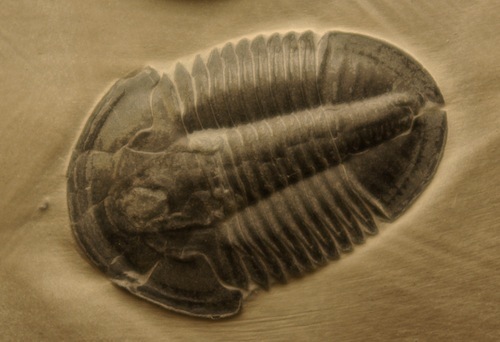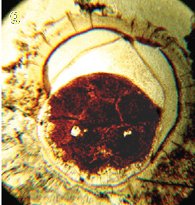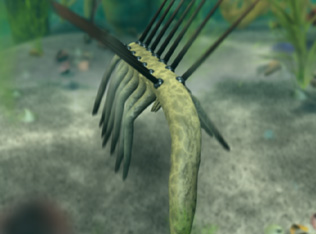 Evolution
Evolution
 Intelligent Design
Intelligent Design
In Explaining the Cambrian Explosion, Has the TalkOrigins Archive Resolved Darwin’s Dilemma?

A correspondent recently referred me to an article in the TalkOrigins Archive responding to the argument that “Complex life forms appear suddenly in the Cambrian explosion, with no ancestral fossils.” TalkOrigins is a popular online resource that collects attempted answers to some often-heard challenges to Darwinian evolutionary theory. The article offers seven responses to the contention that the Cambrian explosion, which occurred some 530 million years ago, represents a significant difficulty for the neo-Darwinian view on how animal body plans evolved.
Since this subject comes up frequently in the evolution debate, as indeed the seeming dilemma posed by the Cambrian event troubled Darwin himself, I here offer a brief reply to TalkOrigins.
Response #1: Complex life preceded the Cambrian.
The article explains,
The Cambrian explosion was the seemingly sudden appearance of a variety of complex animals about 540 million years ago (Mya), but it was not the origin of complex life. Evidence of multicellular life from about 590 and 560 Mya appears in the Doushantuo Formation in China (Chen et al. 2000, 2004), and diverse fossil forms occurred before 555 Mya (Martin et al. 2000). (The Cambrian began 543 Mya., and the Cambrian explosion is considered by many to start with the first trilobites, about 530 Mya.) Testate amoebae are known from about 750 Mya (Porter and Knoll 2000). There are tracelike fossils more than 1,200 Mya in the Stirling Range Formation of Australia (Rasmussen et al. 2002). Eukaryotes (which have relatively complex cells) may have arisen 2,700 Mya, according to fossil chemical evidence (Brocks et al. 1999). Stromatolites show evidence of microbial life 3,430 Mya (Allwood et al. 2006). Fossil microorganisms may have been found from 3,465 Mya (Schopf 1993). There is isotopic evidence of sulfur-reducing bacteria from 3,470 Mya (Shen et al. 2001) and possible evidence of microbial etching of volcanic glass from 3,480 Mya (Furnes et al. 2004).
 None of this is news to us. As the article correctly notes, there is evidence of multicellular life in the Doushantuo formation in China, dating to a few tens of millions of years prior to the Cambrian. Vernanimalcula guizhouena, for example, which is the earliest known Bilateria, is found in deposits dating from 600 to 580 million years ago. The Doushantuo formation also contains fossilized microscopic sponges and corals and various other aquatic microscopic fauna.
None of this is news to us. As the article correctly notes, there is evidence of multicellular life in the Doushantuo formation in China, dating to a few tens of millions of years prior to the Cambrian. Vernanimalcula guizhouena, for example, which is the earliest known Bilateria, is found in deposits dating from 600 to 580 million years ago. The Doushantuo formation also contains fossilized microscopic sponges and corals and various other aquatic microscopic fauna.
Far from resolving Darwin’s dilemma, however, the discovery of these small and fragile organisms has only accentuated the problem, for it substantially undermines the common response that the Precambrian organisms were too small and too soft-bodied to be preserved. The same is true with respect to the testate (shelled) amoebae fossils that date back to the Cryogenian period (850-635 million years ago). None of the organisms mentioned by TalkOrigins represent transitional precursors to the forms that appear so abruptly during the Cambrian explosion.
In any case, as discussed in some detail here, the Ediacaran fauna are not broadly thought to be the ancestors of modern taxonomic groups such as the various metazoan phyla which appear explosively in the Cambrian radiation. The presence of these organisms, therefore, should offer no comfort to Darwinists. As Peter Ward has observed in On Methuselah’s Trail: Living Fossils and the Great Extinctions,
[L]ater study cast doubt on the affinity between these ancient remains preserved in sandstones and living creatures of today; the great German paleontologist A. Seilacher, of T�bingen University, has even gone so far as to suggest that the Ediacaran fauna has no relationship whatsoever with any currently living creatures. In this view, the Ediacaran fauna was completely annihilated before the start of the Cambrian fauna.” (p. 36)
Response #2: Transitional fossils exist.
The article states,
There are transitional fossils within the Cambrian explosion fossils. For example, there are lobopods (basically worms with legs) which are intermediate between arthropods and worms (Conway Morris 1998).
 The famous Hallucigenia (pictured left) was a genus of the lobopods. They also included other well-known groups such as Aysheaia.
The famous Hallucigenia (pictured left) was a genus of the lobopods. They also included other well-known groups such as Aysheaia.
They certainly did have features in common with worms, including their long segmented bodies. At the same time, they had many features in common with arthropods. For example, a study of Miraluolishania haikouensis revealed that their eyes are very similar to those of arthropods (Liu et al., 2004). What we do not find, however, are numerous connecting forms leading from annelid worms to arthropod crustaceans (the arthropod subphylum likely to be the closest related to annelid worms due to their holoblastic form of cleavage). Indeed, lobopods appear in the Cambrian explosion at the same time as the arthropods.
Response #3: Not all phyla appear in the Cambrian.
The article states,
Only some phyla appear in the Cambrian explosion. In particular, all plants postdate the Cambrian, and flowering plants, by far the dominant form of land life today, only appeared about 140 Mya (Brown 1999).
This statement is probably correct. It is likely that all plants do postdate the Cambrian, though there is some debate as to whether certain Ediacaran organisms were animals, plants or fungi. Evidence of the first flowering plants certainly comes much later (as stated, about 140 million years ago). It is not clear, however, how this is relevant to a discussion of the origin of metazoan phyla (the majority of which are represented by the Cambrian animals).
The article continues,
Even among animals, not all types appear in the Cambrian. Cnidarians, sponges, and probably other phyla appeared before the Cambrian. Molecular evidence shows that at least six animal phyla are Precambrian (Wang et al. 1999). Bryozoans appear first in the Ordovician. Many other soft-bodied phyla do not appear in the fossil record until much later. Although many new animal forms appeared during the Cambrian, not all did. According to one reference (Collins 1994), eleven of thirty-two metazoan phyla appear during the Cambrian, one appears Precambrian, eight after the Cambrian, and twelve have no fossil record.
There is one error in this paragraph, but it may be excused since the relevant discovery postdates the article’s writing. Two years ago, researchers identified representatives of the bryozoan phyla (the oldest of which hitherto dated to the Ordovician) from the Cambrian period (Landing et al., 2010). This means that there is now evidence for the origin of all skeletalized metazoan phyla occurring during the Cambrian period. The picture to the left represents a freshwater bryozoan.
Granted, there are soft-bodied phyla that do not make an appearance in the Cambrian (instead they turn up in the fossil record later in the geologic time scale). Some modern organisms, such as Platyhelminths, left practically no impression in the fossil record at all — save for trace fossils and fossil trematode eggs that have been found, for example, in Egyptian mummies. The fossil record definitely reflects significantly weaker preservation of soft-bodied creatures (though, as previously stated, some have been miraculously preserved). But it is the case that all of the skeletalized animals first appear in the Cambrian period.
The TalkOrigins article continues,
And that just considers phyla. Almost none of the animal groups that people think of as groups, such as mammals, reptiles, birds, insects, and spiders, appeared in the Cambrian. The fish that appeared in the Cambrian was unlike any fish alive today.
This is true. But it has never been claimed by ID proponents that groups such as the vertebrate classes (mammals, birds, fish, amphibians, reptiles) appeared during the Cambrian. On the contrary, it is the pattern of morphological disparity preceding diversity that is fundamentally at odds with the neo-Darwinian scenario of gradualism. All of the major differences (i.e. the higher taxonomic categories such as phyla) appear first in the fossil record and then the lesser taxonomic categories such as classes, orders, families, genera and species appear later. On the Darwinian view, one would expect to see all of the major differences in body plan appear only after numerous small-scale speciation events. But this is not what we observe.
Response #4: The Cambrian explosion was not sudden.
TalkOrigins asserts,
The length of the Cambrian explosion is ambiguous and uncertain, but five to ten million years is a reasonable estimate; some say the explosion spans forty million years or more, starting about 553 million years ago. Even the shortest estimate of five million years is hardly sudden.
Five to ten million years (which is the most likely time span) is extremely abrupt relative to the time that would be needed to accomplish those radical innovations in animal form resulting in the origin of many different animal body types. One can expand the amount of time available by grouping together several different radiations that occurred around that time, for example the Tommotian (small shelly) fauna that date to shortly before the Cambrian explosion, albeit within the Cambrian period. But if one focuses specifically on the Cambrian explosion proper, the event indeed occurs within a very narrow window of time.
Response #5: There are plausible explanations for the Cambrian radiation
According to TalkOrigins,
There are some plausible explanations for why diversification may have been relatively sudden.
The article goes on to offer seven possible explanations as to the origin of animal body plans in the Cambrian explosion. The first one is,
The evolution of active predators in the late Precambrian likely spurred the coevolution of hard parts on other animals. These hard parts fossilize much more easily than the previous soft-bodied animals, leading to many more fossils but not necessarily more animals.
There are at least two problems with this hypothesis. First, as already discussed, there are quite a number of cases of fossilized organisms that are entirely soft-bodied. Indeed, entirely soft-bodied representatives of several phyla have been identified as belonging to both the Cambrian and the Precambrian. But none of them represent feasible precursors to the Cambrian fauna. The sharp increase in organismal complexity and morphological disparity between the Precambrian and the Cambrian is much too big to accept this explanation.
The second problem with the proposal is that the survival of a number of phyla (e.g. arthropods, brachiopods) depends strongly upon their ability to shield their soft parts from the environment. It is thus implausible that these organisms first evolved their soft parts and added their harder parts later. Soft and hard parts had to arise together.
The article continues,
Early complex animals may have been nearly microscopic. Apparent fossil animals smaller than 0.2 mm have been found in the Doushantuo Formation, China, forty to fifty-five million years before the Cambrian (Chen et al. 2004). Much of the early evolution could have simply been too small to see.
But we can see such microfossils. And if these microfossils can be observed in the Doushantuo Formation, why can’t we observe any precursors to the animals that appear in the Cambrian?
We are further told,
The earth was just coming out of a global ice age at the beginning of the Cambrian (Hoffman 1998; Kerr 2000). A “snowball earth” before the Cambrian explosion may have hindered development of complexity or kept populations down so that fossils would be too rare to expect to find today. The more favorable environment after the snowball earth would have opened new niches for life to evolve into.
As noted previously, the Ediacaran assemblages reveal a plethora of soft-bodied organisms. The assertion that Precambrian animals were rare is refuted by the abundance of those fossils. For a review, see McCall (2006).
In any case, the last “snowball earth” episode is thought to have ended about 630 million years ago. That’s approximately 100 million years prior to the Cambrian explosion.
The article also claims that,
Hox genes, which control much of an animal’s basic body plan, were likely first evolving around that time. Development of these genes might have just then allowed the raw materials for body plans to diversify (Carroll 1997).
Even leaving aside the numerous problems with evo devo, the hypothesis that Hox genes were the innovation that triggered the Cambrian explosion has now been discredited. Rosa et al. (1999) reported that the diversification of Hox genes occurred well before the radiation of the three bilaterian clades (lophotrochozoans, deuterostomes and ecdysozoans). As the paper notes, “The major period of Hox gene expansion and diversification thus occurred before the radiation of each of the three great bilaterian clades.” This point is also stated in a recent review in Science (Erwin et al., 2011).
We get another potential explanation:
Atmospheric oxygen may have increased at the start of the Cambrian (Canfield and Teske 1996; Logan et al. 1995; Thomas 1997).
Quite possibly. But a rise in atmospheric oxygen does nothing to explain the origin of the novel body plans that arise during the Cambrian. This requires innovations in information at the nucleotide sequence level as well as at the level of higher orders of information necessary for determining organismal morphology. Hand waving this problem away by pointing to a rise in atmospheric oxygen isn’t going to cut it.
An additional hypothesis given claims that,
Planktonic grazers began producing fecal pellets that fell to the bottom of the ocean rapidly, profoundly changing the ocean state, especially its oxygenation (Logan et al. 1995).
Again, the connection between a rise in ocean oxygenation and large-scale innovations in form and structure that is observed during the Cambrian explosion is not clear. As Erwin et al. (2011) explain, although a permissive environment “might facilitate the appearance of large and ecologically diverse animals in the fossil record,” it “does not explain innovations in metazoan architecture.”
And finally,
Unusual amounts of phosphate were deposited in shallow seas at the start of the Cambrian (Cook and Shergold 1986; Lipps and Signor 1992).
As Casey Luskin recently observed, however,
Citing increased chemical weathering around the time of the Cambrian explosion doesn’t explain the abrupt appearance of new genes and other genetic information needed to generate new body plans. If they expect us to believe that sedimentation rates explain the sudden origin of new body plans, then it would seem that the Cambrian explosion is still a “mystery.”
Of course, none of these proposals really explains the Cambrian explosion. Rather, as Casey points out, they are all attempts to explain it away. There is a difference, however, between interpreting evidence within the framework of a paradigm (and rationalizing incongruent data) and the theory actually finding support from the evidence.
Response #6: The Cambrian animals are unlike anything alive today.
TalkOrigins states that,
Cambrian life was still unlike almost everything alive today. Although several phyla appear to have diverged in the Early Cambrian or before, most of the phylum-level body plans appear in the fossil record much later (Budd and Jensen 2000). Using number of cell types as a measure of complexity, we see that complexity has been increasing more or less constantly since the beginning of the Cambrian (Valentine et al. 1994).
I am not quite sure what TalkOrigins is getting at with this statement. We certainly see increases in complexity after the Cambrian. But, contrary to what seems to be suggested here, the majority of phylum-level body plans that have left a fossil record do appear in the Cambrian.
Response #7: There have been other major radiations of life.
Finally, TalkOrigins points out:
Major radiations of life forms have occurred at other times, too. One of the most extensive diversifications of life occurred in the Ordovician, for example (Miller 1997).
This is, of course, true. But its relevance to a discussion of the Cambrian explosion isn’t clear, except perhaps to document that saltation (sudden appearance) is a defining characteristic of the fossil record generally. How this fact has anything to do with explaining the Cambrian explosion is anybody’s guess.
Conclusion
In summary, TalkOrigins has failed to provide us with a feasible naturalistic explanation for the Cambrian explosion. The facts that the article draws upon are either irrelevant to the subject at hand or accentuate the problem. The Cambrian explosion continues to represent a formidable challenge to the neo-Darwinian theory of evolutionary gradualism.
